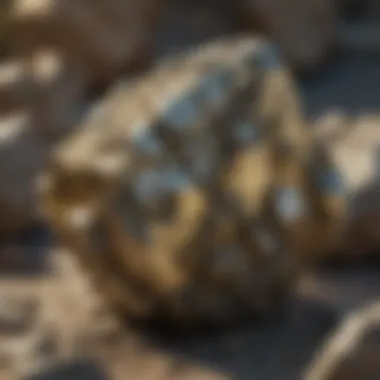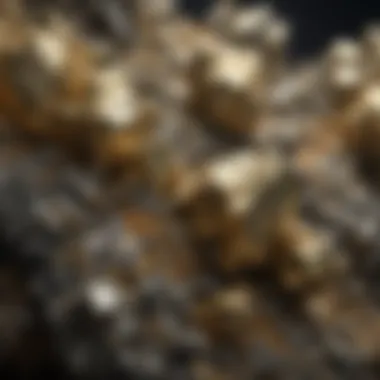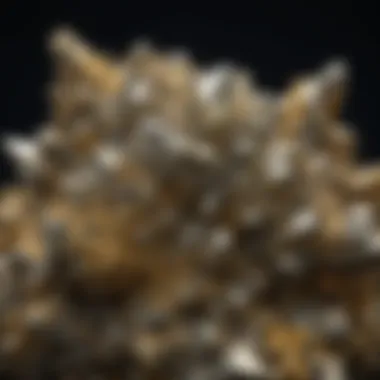A Comprehensive Guide to Purchasing Pyrite Specimens for Rock and Fossil Collectors


Rock and Fossil Identification
When it comes to collecting pyrite specimens for rock and fossil enthusiasts, understanding rock and fossil identification is crucial. This section delves into the different types of rocks and fossils that contain pyrite, such as sedimentary, metamorphic, and igneous rocks. Characteristics to look for when identifying pyrite include its metallic luster, brassy yellow color, and distinct cubic crystal structure. Utilizing tools like a magnifying glass and a hardness testing kit can further aid in accurate identification.
Collecting Tips and Techniques
For collectors looking to expand their pyrite collections, adopting best practices for collecting is essential. This includes researching and locating prime collecting sites known for yielding high-quality pyrite specimens. Additionally, knowing how to safely extract specimens without causing damage is paramount. Techniques such as using rock hammers and chisels with caution can help collectors retrieve pyrite samples intact.
Preservation and Display
Once pyrite specimens are collected, proper preservation and display are key to maintaining their integrity. Preserving rocks and fossils involves methods like wrapping specimens in acid-free paper and storing them in airtight containers to prevent oxidation. For display, creative ideas such as arranging pyrite samples in shadow boxes or incorporating them into themed dioramas can enhance their visual appeal.
Geological Insights
To deepen the understanding of pyrite and its geological significance, exploring geological insights is imperative. This section delves into the formation processes of pyrite within different rock types, shedding light on the mineral's historical significance and its role in notable scientific discoveries. From the fascinating geological formations where pyrite is found to the remarkable discoveries made by geologists and paleontologists, delving into these insights adds a layer of appreciation for pyrite among collectors.
Introduction
In the world of rock and fossil collecting, the allure of pyrite stands out as a captivating subject for enthusiasts. This valuable guide serves as a gateway to understanding the intrinsic beauty and unique qualities of pyrite specimens available in the market. Exploring everything from its composition and structure to its formation and occurrence, this article dives deep into the world of pyrite acquisition. By unraveling the significance of pyrite in collections, this guide aims to equip collectors with the essential knowledge needed to make informed decisions and enrich their collections.
Understanding Pyrite
Composition and Structure of Pyrite
Delving into the compositions and structures of pyrite unveils a world of intricate details that make this mineral a coveted choice for collectors. Its distinct cubic form, combined with the presence of iron and sulfur elements, contributes to its renowned metallic luster. The unique crystalline structure of pyrite not only adds to its visual appeal but also sets it apart as a desirable addition to any collection.
Common Characteristics of Pyrite
Pyrite's common characteristics, such as its brassy-yellow color and metallic sheen, make it easily recognizable among other minerals. The mineral's hardness and brittleness also play a role in its durability and susceptibility to natural elements. Understanding these traits is essential in distinguishing authentic pyrite specimens and ensuring their longevity in collections.
Formation and Occurrence of Pyrite
The formation and occurrence of pyrite in nature provide insight into its geological significance. Pyrite commonly occurs in sedimentary rocks, hydrothermal veins, and coal seams, reflecting its diverse origins. The mineral's association with different geological processes adds layers of complexity to its story, making each specimen a unique piece of Earth's history.


Significance of Pyrite in Collections
Decorative Purposes
Pyrite's aesthetic appeal transcends its geological origins, often used for ornamental purposes in jewelry and home decor. Its golden hue and metallic luster lend an opulent touch to any display, attracting collectors seeking visually striking additions to their showcases.
Metaphysical Properties
Beyond its physical allure, pyrite is revered for its metaphysical properties, believed to possess protective and energizing qualities by crystal healing practitioners. The mineral's association with vitality and positivity elevates its value beyond aesthetics, appealing to collectors interested in the spiritual aspects of gemstones.
Industrial Uses
Pyrite's industrial uses extend to various sectors, including construction, manufacturing, and energy production. Its presence in sulfuric acid production and as a source of iron and sulfur underscores its practical utility in modern industries. Understanding these industrial applications sheds light on the diversified value of pyrite beyond its collectible nature.
Factors to Consider When Buying Pyrite
In the realm of rock and fossil collecting, the importance of considering various factors before purchasing pyrite specimens cannot be overstated. To ensure a satisfactory acquisition, collectors must delve into the authenticity and quality of the pyrite, evaluating physical characteristics, certifications and verification, as well as identifying any presence of impurities. This critical examination guarantees that collectors are acquiring genuine and high-quality pyrite specimens that meet their desired standards, thus enhancing the overall value and experience of their collections.
Authenticity and Quality
Physical Characteristics
When embarking on the journey of acquiring pyrite specimens, understanding the physical characteristics plays a pivotal role in discerning the quality and authenticity of the mineral. The color, luster, and crystal form of pyrite are key indicators of its purity and value. Collectors should focus on vibrant gold hues, dazzling luster, and well-defined crystal structures when selecting pyrite specimens. These characteristics not only enhance the visual appeal of the specimen but also signify its geological integrity and desirability within the realm of rock and fossil collections.
Certifications and Verification
In the pursuit of acquiring authentic and high-quality pyrite specimens, certifications and verification processes play a crucial role in establishing the credibility and origin of the mineral. Collectors should prioritize specimens that come with reputable certifications, ensuring that experts have verified the pyrite's authenticity and quality. By seeking certified pyrite specimens, collectors can confidently add valuable and certified pieces to their collections, reflecting a commitment to authenticity and excellence.
Presence of Impurities
Evaluating the presence of impurities is essential when considering pyrite specimens for acquisition. High-quality pyrite should exhibit minimal impurities, such as extraneous minerals or structural defects, which may detract from its visual appeal and intrinsic value. Collectors should opt for specimens with few to no impurities, as this indicates the purity and integrity of the pyrite, enhancing its significance and desirability within the collector's showcase.
Sourcing and Origin
Ethical Mining Practices


When exploring the sourcing and origin of pyrite specimens, ethical mining practices emerge as a significant aspect to consider. The ethical extraction of pyrite ensures that collectors are acquiring specimens sourced through environmentally responsible and socially conscious methods. By supporting ethical mining practices, collectors contribute to sustainable mineral sourcing and ethical stewardship, enriching the value and ethical standing of their pyrite collections.
Localities and Geological Context
Understanding the localities and geological context of pyrite specimens enriches collectors' appreciation and knowledge of the mineral's origins. Different regions yield varying types of pyrite, each with its distinct characteristics and historical significance. Collectors should seek specimens sourced from renowned localities with geological importance, enhancing the educational and geological value of their pyrite collections.
Rare and Unique Varieties
Exploring rare and unique varieties of pyrite adds a layer of exclusivity and intrigue to collectors' acquisitions. Rare pyrite specimens, such as twinned crystals or intricate formations, hold a special allure for collectors seeking distinctive and exceptional additions to their collections. By acquiring rare and unique pyrite varieties, collectors elevate the diversity and prestige of their mineral showcases, creating a captivating display of geological wonders.
Pricing and Value
Market Trends
Keeping abreast of current market trends is vital when assessing the pricing and value of pyrite specimens. Fluctuations in demand, rarity, and aesthetics impact the market value of pyrite, influencing collectors' purchasing decisions. By monitoring market trends, collectors gain insights into pricing dynamics and investment opportunities, empowering them to make informed acquisitions and capitalize on emerging trends within the rock and fossil collecting community.
Rareness and Rarity Factors
The rarity of pyrite specimens contributes significantly to their value and desirability among collectors. Rareness factors, such as unique crystal forms, exceptional color variations, or scarce geological occurrences, imbue pyrite specimens with a sense of exclusivity and allure. Collectors seeking to expand their collections with rare and coveted pyrite specimens should prioritize acquiring unique varieties that resonate with their collecting goals and preferences.
Investment Potential
For collectors considering pyrite acquisitions as potential investments, understanding the mineral's investment potential is crucial in making informed decisions. Pyrite specimens with intrinsic value, historical significance, or rare characteristics hold long-term investment appeal for collectors interested in asset diversification. By assessing the investment potential of pyrite specimens, collectors can strategically enhance their collections, blending the joys of collecting with the potential for financial growth and portfolio enrichment.
Where to Buy Pyrite
In the realm of acquiring pyrite specimens, the matter of where to obtain them is of paramount importance. This section delves into various avenues through which rock and fossil collectors can procure pyrite, each presenting unique benefits and considerations. By understanding the different sources available, enthusiasts can make informed decisions about expanding their collections effectively.
Specialty Rock and Mineral Shops
Physical Stores
Specialty rock and mineral shops that have physical locations offer a distinct advantage to collectors. These brick-and-mortar establishments allow enthusiasts to physically inspect and choose pyrite specimens, providing a hands-on experience that online platforms may lack. The tactile engagement with the specimens in person can offer a deeper appreciation and understanding of the unique qualities of each pyrite piece. Additionally, interacting with knowledgeable staff members who share a passion for rocks and fossils can enhance the buying experience, as they often provide valuable insights and guidance on selecting the right pyrite specimens.


Online Retailers
In contrast, online retailers provide convenience and accessibility to a global audience of collectors. The key characteristic of online retailers lies in their extensive inventories, offering a vast selection of pyrite specimens from various sources around the world. This wide range allows collectors to explore different types of pyrite, including rare and unique varieties that may not be readily available in physical stores. However, a potential downside of online shopping is the inability to inspect the specimens personally before making a purchase, highlighting the importance of verifying the seller's credibility and return policies to ensure a satisfactory transaction.
Reputable Sellers and Dealers
Opting to purchase pyrite from reputable sellers and dealers is crucial in ensuring the authenticity and quality of the specimens. These individuals or companies have established a trusted reputation within the collecting community, often backed by certifications and positive reviews from satisfied customers. The key advantage of choosing reputable sellers lies in the assurance of acquiring genuine pyrite specimens that align with the declared quality standards. While the prices from reputable sellers may reflect the higher quality and authenticity of the specimens, the peace of mind and trustworthiness that come with such purchases make them a worthwhile investment for devoted collectors.
Tips for Evaluating Pyrite Specimens
When delving into the world of pyrite specimens, it is crucial to have a keen eye for detail and a deep understanding of what to look for when evaluating these fascinating mineral samples. Evaluating pyrite specimens involves a meticulous examination of various key elements that can provide invaluable insights into their quality and authenticity. By focusing on specific factors such as color, luster, crystal form, fracture patterns, inclusions, and twinning, collectors can gain a comprehensive understanding of the unique characteristics of each pyrite specimen.
Physical Examination
Color, Luster, and Crystal Form
Color, luster, and crystal form are fundamental aspects to consider when evaluating pyrite specimens. These qualities not only contribute to the overall visual appeal of the specimens but also offer insights into their formation and structure. The vibrant metallic yellow color, brilliant luster, and distinctive crystal forms of pyrite are highly sought after by collectors due to their aesthetic appeal and rarity. Assessing the color consistency, luster intensity, and crystal symmetry of pyrite specimens can reveal valuable information about their authenticity and provenance.
Fracture Patterns
Fracture patterns play a significant role in determining the quality and durability of pyrite specimens. Examining the fracture patterns can help collectors assess the structural integrity of the specimens and identify any potential weaknesses or imperfections. Pyrite specimens with well-defined fracture patterns and minimal evidence of cleavage are typically considered more desirable due to their robustness and aesthetic appeal. Understanding the different types of fracture patterns in pyrite can aid collectors in making informed decisions when selecting specimens for their collections.
Inclusions and Twinning
Inclusions and twinning are distinctive features that can add character and significance to pyrite specimens. Inclusions, such as other minerals or organic materials trapped within the pyrite crystals, can provide clues about the specimen's geological history and formation process. Twinning, where two or more crystals grow together in a symmetrical manner, can enhance the visual appeal and uniqueness of pyrite specimens. Careful examination of inclusions and twinning patterns can help collectors appreciate the complexity and beauty of pyrite formations, making each specimen a fascinating addition to their collection.
Conclusion
Final Thoughts on Buying Pyrite
Informed Decision-Making
Embarking on the path of informed decision-making when acquiring pyrite specimens is paramount in ensuring a valuable and fulfilling collection. By meticulously examining the authenticity, quality, and sourcing of pyrite, collectors can make educated choices that align with their preferences and collection goals. This strategic approach empowers enthusiasts to select specimens that not only meet their criteria but also potentially hold investment value in the long run. Embracing informed decision-making elevates the buying experience, enriching collections with authentic and high-quality pyrite pieces.
Enhancing Your Collection
Enhancing one's collection goes beyond just acquiring pyrite specimens; it embodies a quest for uniqueness, quality, and artistic value. By selecting pyrite pieces that complement the existing collection in terms of color variation, crystal formations, and rarity, collectors can create visually captivating displays that showcase the beauty and diversity of pyrite. Moreover, each addition brings a new dimension to the collection, offering a deepened understanding of pyrite's geological significance and aesthetic allure. The process of enhancing a collection not only satisfies the collector's aesthetic inclinations but also fuels a continuous appreciation for the wonders of pyrite.
Appreciating the Beauty of Pyrite
At the heart of collecting pyrite lies the profound appreciation for its innate beauty and captivating features. The golden metallic luster, intricate crystal structures, and varied formations of pyrite specimens evoke a sense of wonder and admiration. By immersing oneself in the inherent allure of pyrite, collectors can develop a keen eye for discerning subtle differences in color, texture, and rarity among specimens. This appreciation transcends mere visual appeal, fostering a deeper connection with the mineral world and igniting a passion for discovering the hidden treasures within each pyrite specimen. Through appreciating the beauty of pyrite, collectors embark on a fulfilling journey of exploration and admiration, cherishing each piece for its unique charm and geological significance.







